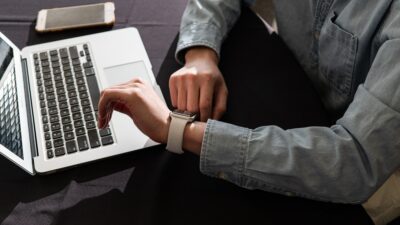Biometric identification has an ever-present role in our everyday security – from the workplace to airports, our tablets to our home assistants and banking to law enforcement.
While biometrics may sound like something out of a Science Fiction film, it is very much our reality and there is a lot that goes into what biometrics is and how it works. In this article, we will cover these topics plus the benefits of using this type of identification software for time and attendance, but first, let’s define what biometrics actually are.
Biometrics – a definition
So what are biometrics, to be exact?
Biometrics refers to the techniques used to automatically identify an individual based on their physical or behavioural characteristics. Common examples of biometrics include iris and retina scanning, fingerprint identification, voice recognition, and face and hand recognition.
The reason biometrics are more secure than other ways of confirming someone’s identity, is that physical characteristics are relatively fixed (i.e. fingerprints) and unique to every individual. It is also extremely difficult to ‘cheat the system’ when it comes to biometrics — even in the case of twins.
According to Spiceworks, biometric authentication technology is already utilised in 62% of companies, and an additional 24% plan to utilise it within two years.
How do biometrics work?
Although biometric systems may sound like they are complicated to understand and implement, biometrics such as fingerprint clocking systems tend to follow the same simple steps:
1. Enrolling staff
As a starting point, all employees need to be enrolled onto the biometric system. This involves the system recording basic information about you such as your name or an identification number. It will then capture an image (i.e. of your fingerprint) or record a specific trait (i.e. your voice) depending on the type of system.
2. Securely storing staffs biometrics
Instead of storing the complete image of your fingerprint or iris, for example, as that could compromise the privacy of employees, the trait that was recorded is analysed and then translated into a line of code or a graph – meaning the original data is not stored in its original form.
3. Matching
The next time you use the system after enrolling, it will attempt to match the trait you present to the information it has stored on file. In doing so, this will either accept or reject your attempt to ‘clock in’ to an area or device.
Fingerprint scanning is the most common form of biometric authentication in the workplace, with 57% of organisations reporting to use it in some capacity.
What are biometrics used for in the workplace?
When it comes to the workplace specifically, biometrics can be used to enhance the employee experience and also the security of the workplace in a number of ways. Biometrics pose a great solution to the security of a building and IT systems, but also for tracking the time and attendance of employees.
1. Logging into company devices
Biometric authentication allows businesses to get rid of the hassle of using PINs and passwords to log into PCs or laptops, making company security more convenient and secure. Biometrics can also be part of a multi-factor authentication scenario, combining either several forms of biometrics, such as fingerprints, face and iris, or biometrics with existing PIN or password-based login, for stronger authentication.
2. Restricting and giving access to certain employees
Often, biometrics are used in the workplace to control both employee and non-employee access to certain areas of a building. For example, all employees will need access to the entrance to the building, but not all employees need access to areas containing sensitive information or highly critical equipment, such as server rooms.
This also increases the building’s security from intruders or visitors as they will not be able to access the restricted areas even if they attempt to use their fingerprint to gain access. Management will be able to assign and take away access from individual employees using the corresponding software for a simple and secure access solution.
? Want to learn more about access control? Download our guide on preventing unauthorised access to your building here.
3. Time, attendance and absence monitoring
Biometrics can also be used to record employee attendance, working hours and absences. This ensures that employees are only paid for the hours they work and reduces the chance of time and attendance errors and also time fraud. Many companies are taking advantage of the accuracy, efficiency and ease of using a biometric system to monitor employee time and attendance.

Why use biometrics for time and attendance?
Let’s look at the benefits of installing a biometric system to monitor time and attendance within the workplace in a little more detail:
Crack down on ‘buddy punching’
One of the biggest benefits of biometrics for attendance and time keeping in a business is that employees will be unable to clock in for each other. This type of time theft is known as buddy punching and costs many companies tens of thousands of pounds each year.
Biometric characteristics cannot be duplicated, which prevents employees from signing in on behalf of their colleagues when they aren’t in the building.
Learn more about buddy punching and how to prevent it.
Increased productivity
Implementing biometric systems to monitor time and attendance removes the need to log time manually. This not only saves employees time but also reduces staffing overheads and provides a more accurate picture of work related data to the payroll department, helping to increase productivity.
Cost savings once installed
A biometric system removes the need to issue or replace cards and keys. Additionally, both employees and administrators consistently save time in situations such as; time spent waiting in line to enter a building, time looking for a key or card, time lost when a user can’t enter a building because they don’t have their key or card, and staff time required to issue a new key or card.
Increase employee accountability
With biometric systems in place, employees are more likely to be accountable for the actions they make. Since employees are able to be easily identified and held accountable for taking extended or frequent breaks, unscheduled lunches or other misuses of their time.

How safe is a biometric time and attendance system?
A biometric time and attendance system is completely safe and secure to use. It can only be used, and data accessed, by the employer. For further peace of mind, systems can typically only be used for tracking time and attendance and providing access to employees to certain areas of the building.
? Want to learn more about preventing unauthorised access to your buildings? Download our guide on ‘What is Unauthorised Access and How to Prevent it’ here.
Our biometric fingerprint devices don’t hold any biometric data that could be used elsewhere. A random collection of data is taken from the first image of a user’s fingerprint (rather than a full identifiable scan) which is then encrypted and stored on the device – with the original image being deleted and completely untraceable.
It is therefore impossible for anyone to access the images of an employee’s fingerprint from the biometric scanner, as the original fingerprint image does not exist in the system – leaving behind only a piece of mathematical code that is able to understand which employee is attempting to clock in.
Because of this, biometric systems that work in this way, such as our industry leading solution are completely GDPR compliant and absolutely safe to use.
Conclusion
You may be fully on board with the idea of a biometric time and attendance system, but your employees may still be unsure. It could be that they are worried about the privacy and storage of their personal information or perhaps they are concerned about their privacy. The key here is simply to keep them informed to mitigate any concerns they may have. You should also inform employees as to how their data will be used and stored, and emphasise the benefits of using the system.
Once you have smoothed out any doubts about biometrics, you’ll find that it’s a secure, efficient and easy-to-use system that will save your business time on manual admin and also improve employee time management.
Using biometrics for time and attendance management is a forward thinking, time saving and cost saving solution that is both safe and secure.
—
If you’d like support in choosing a biometric time and attendance system that suits you, get in touch with us today on sales@mitrefinch.co.uk or 0330 726 0066. For more information on our time and attendance software or workforce management solutions, contact Mitrefinch today.




